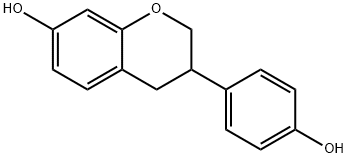94105-90-5
 94105-90-5 結(jié)構(gòu)式
94105-90-5 結(jié)構(gòu)式
基本信息
(+)-雌馬酚
R,S-雌馬酚
納米脂質(zhì)體雌馬酚
(鹵)-EQUOL
雌馬酚,(±)-雌馬酚
雌馬酚 98% 不是S型,混旋的
3-(4-羥基苯基)四氫苯并吡喃-7-醇
(+/-)Equol
(+/-)-EQUOL
Equol,99%e.e.
EQUOL(RACEMIC)
(+/-)-Equol>
(+/-)-Equol (GMP)
7,4'-HoMoisoflavane
(±)-EQUOL >= 99.0% (TLC)
4′,7-Dihydroxyisoflavane
物理化學(xué)性質(zhì)
常見問題列表
Equol is first isolated and identified from pregnant-mares' urine and later found in the urine of the goat, cow, hen and sheep. Equol, unlike the soy isoflavones daidzein or genistein, has a chiral center and therefore can occur as 2 distinct diastereoisomers. S-equol is the exclusive product of human intestinal bacterial synthesis from soy isoflavones and both enantiomers are bioavailable. S-equol has a high affinity for estrogen receptor beta (K i =0.73 nM), whereas R-equol is relatively inactive. Equol could promote the proliferation and differentiation of rat osteoblasts through activating the ER-PKCα-related signaling pathway. The alkaline phosphatase activity also increases significantly in all of the equol and 17β-estradiol (E2 ) groups. Equol also significantly elevates the osteocalcin levels.
Equol is a modest natriuretic and vasorelaxant agent in the rat. Orally administered equol is about 8-fold less potent than orally administered furosemide. In isolated aortic rings precontracted by administration of phenylephrine, administration of equol relaxes the contracted aorta (concentration for half-maximal activity 58.9±16 μM). Equol possesses anticancer activity that suppresses tumor formation via apoptosis induction in rats with DMBA-induced mammary gland tumors. In addition, equol shows a hepatic protective effect by acting as an antioxidant and by reducing apoptosis.
